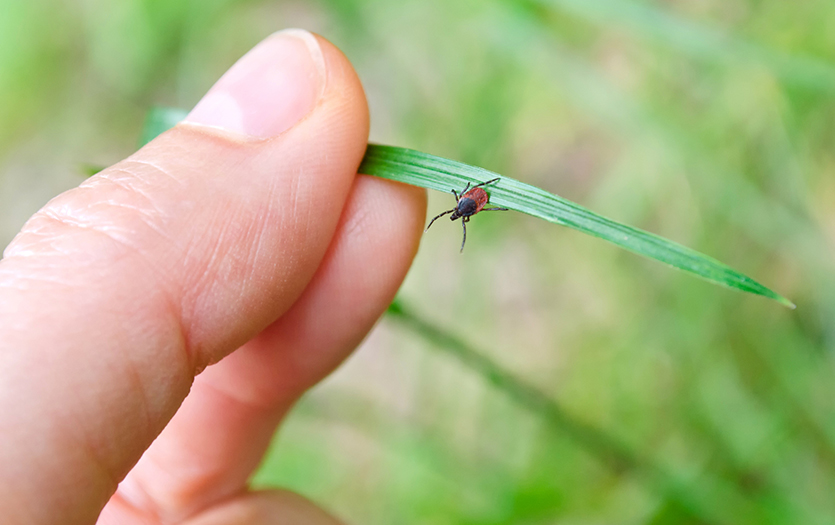
This post was written by Michael Davis, DO, Parkview Infectious Diseases.
Imagine it's a warm summer day in the park. The grass is overgrown, and there are tons of people milling about along the path through the woods. Just out of sight, with front legs bouncing in the wind and back legs holding tightly to a blade of grass, is the Ixodes scapularis. The Ixodes scapularis, commonly known as the deer tick, patiently waits for an unsuspecting human to brush against its blade of grass, presenting the perfect opportunity to secure its next blood meal. The feast may last several days, but if its journey is successful, the tick will be set for the season and begin transforming to the next stage of life.
The tick's journey to the next stage in its life cycle sets the scene for our discussion of tick-borne illnesses. This anecdote might sound like a spooky campfire tale, but the spread of tick-borne diseases is a growing concern. To best protect yourself from this bloodthirsty parasite, follow along as we outline common diseases carried by ticks, how they are transmitted and how to respond if bitten.
The tick problem
Ticks are fascinating eight-legged arthropods that live among different types of species and inhabit various regions of the world. They also can carry an extensive list of bacteria, viruses and parasites that can cause human infections.
As the climate continues to change, various tick species are spreading into regions they weren't found before, increasing the spread and diversity of infections. In the upper Midwest, the species we encounter most often is the Ixodes scapularis (deer tick). This variety of tick carries and transmits infections such as:
- Lyme disease (Borrelia burgdorferi – bacteria)
- Anaplasmosis (Anaplasma phagocytophilum – bacteria)
- Babesiosis (Babesia microti – protozoa)
- Powassan virus
Of these pathogens, Lyme disease is the most prevalent; however, a single tick bite can transmit more than one type of pathogen and lead to multiple infections. Common symptoms associated with tick-borne illnesses are:
If you've been spending time outdoors and developed an unexplained fever and headache, it may be worth asking your primary care doctor if you could have a tick-borne infection.
Life cycle
Ticks are typically more active in the summer and fall. They generally have four stages of life – egg, larva, nymph and adult – and require a blood meal at each stage to survive. Unable to jump or fly, they rely on "questing" behavior to crawl onto their victims. During questing, ticks cling to vegetation with their back legs while their front legs are extended in the air, waiting to grab ahold of mammals as they brush against the foliage.
Once aboard their host, ticks find a safe place to enjoy a blood meal in peace, as it takes several days for them to feed. They make a small incision in the skin, bury their head and feeding tube and release a cement-like substance to anchor themselves in place. While feeding, ticks secrete a small amount of saliva with anesthetic properties so that you do not realize they are sucking your blood.
Infection transmission
Nymphal and adult ticks usually transmit infections after acquiring a pathogen earlier in their life cycles from feeding on other small mammals carrying the infectious agent. Pathogens causing Lyme disease, anaplasmosis and babesiosis typically take 24-72 hours to move from the tick's gut into the saliva to infect humans. A tick can transmit the Powassan virus within minutes of attachment.
Prevention
Ticks generally like to live in tall grass, brush and wooded areas where animals or humans are likely to pass by, which increases their chances of acquiring a blood meal. To reduce your risk:
- Stay in the center of trails or paths, where you're less likely to encounter tall grass or brush.
- Consider wearing long socks and pants while treading through high-risk areas. Tuck your pants into your socks for extra security.
- Treat your clothing and gear with 0.5% permethrin, which is still protective even after several washes.
- Use EPA-registered insect repellants containing DEET, picaridin or lemon eucalyptus oil. A list of EPA-approved agents to prevent insect bites is available here.
Ticks are tiny and easy to miss, especially in the nymph and young adult stages. Here are some additional measures that you can take to prevent tick bites:
- Thoroughly check your body and clothes for ticks once you finish your outdoor adventure. Vital areas to check include:
- Under the arms
- In and around the ears
- Inside the belly button
- Back of the knees
- In and around the hair
- Between the legs
- Around the waist
- Remove ticks from your clothing by washing them in hot water or tumble drying them on high heat for 10 minutes.
- Shower within two hours of coming indoors. Early showering reduces the risk of tick-borne infections as the water can wash away unattached ticks and provide another opportunity to check your body for unwanted stragglers.
What to do if you're bitten
If you notice the small black body of an insect with perceptible legs wriggling about embedded in your skin, it could be a tick. Removing the tick as soon as possible is essential to lower your risk of infection. Follow these steps to remove the tick safely:
Step 1: Find and disinfect a pair of fine-tipped tweezers.
Step 2: Grasp the tick as close to the skin's surface as possible and pull upward with steady pressure to prevent the tick's mouth parts from breaking off in the skin.
Step 3: Avoid crushing the tick. Flush it down the toilet, place it in a sealable container with isopropyl alcohol or wrap it tightly with tape.
Step 4: Use tweezers to extract any remaining mouthparts. If you can't remove them, the skin will naturally expel them as it heals.
Step 5: Clean the bite site with rubbing alcohol or soap and water.
If the tick was round and engorged, notify your primary care provider, as it may have attached long enough to transmit an infection. If not, monitor for fever, headache or rash symptoms over the next week and inform your doctor if symptoms develop. Your doctor can prescribe an antibiotic that effectively kills most tick-borne infections.
Concluding thoughts
Reducing your exposure to ticks is the best line of defense against the diseases they transmit. Always perform thorough tick checks after spending time outdoors and don't hesitate to seek medical attention if you suspect a bite.
Additional resources:



